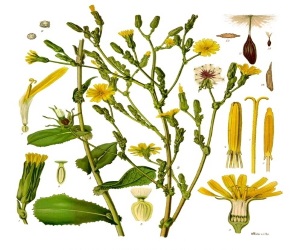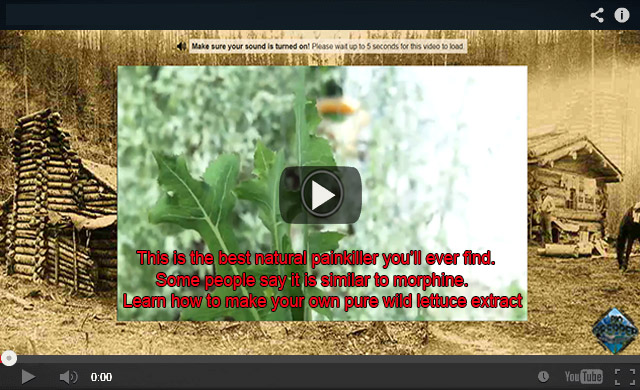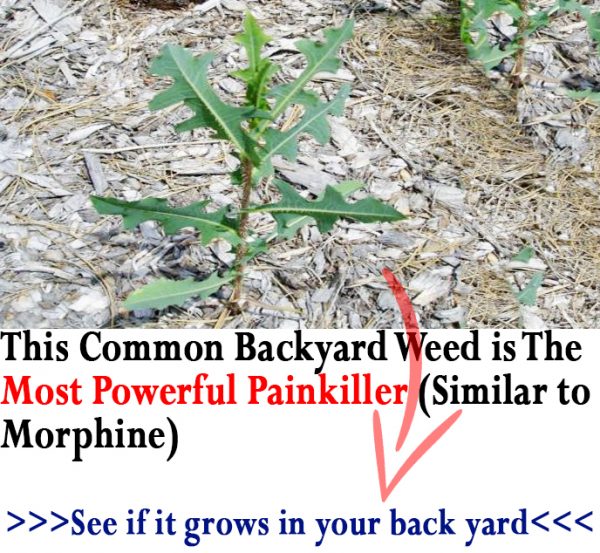Wild lettuce is a plant. The leaves, sap (latex), and seed are used to make medicine.
Wild lettuce has been used since the 19th century for pain relief, to help induce sleep and as a tonic for the nervous system. It was traditionally used by native North Americans for lucid dreaming purposes.
The origins of Wild lettuce are traced back to ancient Egypt where hieroglyphics often depict Min, a fertility god, with the plant. It was believed to be an aphrodisiac and psychoactive substance. Today Wild lettuce may be found growing in southern parts of the United States and across central and southern Europe. It grows in well-drained sandy soils around fields, vacant lots and roadsides.
This relaxing herb can be beneficial for people needing help to get to sleep, calm restlessness or anxiety, and even as an aid when overcoming tobacco and cannabis habits.
Wild lettuce is used for whooping cough, asthma, urinary tract problems, cough, trouble sleeping (insomnia), restlessness, excitability in children, painful menstrual periods, excessive sex drive in women (nymphomania), muscular or joint pains, poor circulation, swollen genitals in men (priapism), and as an opium substitute in cough preparations.
The seed oil is used for “hardening of the arteries” (atherosclerosis) and as a substitute for wheat germ oil.
Some people inhale wild lettuce for a recreational “high” or hallucinogenic effect.
How does it work? Wild lettuce has calming, relaxing, and pain relieving effects.
Whooping cough.
Asthma.
Urinary tract problems.
Cough.
“Hardening of the arteries” (atherosclerosis).
Trouble sleeping (insomnia).
Restlessness.
Painful menstrual periods.
Sexual disorders.
Muscle and joint pain.
Killing germs, when the latex is applied to the skin.
This milky sap contains sesquiterpene lactones, which are essentially the active chemicals responsible for its opiate and pain relieving properties. According to one study, just a 30 mg/kg mg dose of lactucopicrin, the active compound, is comparable to a 60 mg/kg dose of ibuprofen .
Other conditions.
More evidence is needed to rate the effectiveness of wild lettuce for these uses.
Wild lettuce seems safe for most people in small amounts. Large amounts, however, can slow breathing and might cause death.
Applying wild lettuce directly to the skin can cause irritation. Large amounts can cause sweating, fast heartbeat, pupil dilation, dizziness, ringing in the ears, vision changes, sedation, breathing difficulty, and death.
Special Precautions & Warnings:
Pregnancy and breast-feeding: Not enough is known about the use of wild lettuce during pregnancy and breast-feeding. Stay on the safe side and avoid use.
Enlarged prostate (benign prostatic hyperplasia, BPH): Don’t use wild lettuce if you have this condition. It contains a chemical that can harm people who have trouble urinating.
Allergy to ragweed and related plants: Wild lettuce may cause an allergic reaction in people who are sensitive to the Asteraceae/Compositae family. Members of this family include ragweed, chrysanthemums, marigolds, daisies, and many others. If you have allergies, be sure to check with your healthcare provider before taking wild lettuce.
Narrow-angle glaucoma: Don’t use wild lettuce if you have this eye condition. It contains a chemical that might make glaucoma worse.
Surgery: Wild lettuce can affect the central nervous system. There is a concern that it might cause too much sleepiness if it is taken along with anesthesia and other nerve-numbing medications used during and after surgery. Stop using wild lettuce at least 2 weeks before a scheduled surgery.
Sedative medications (CNS depressants) interacts with WILD LETTUCE
Wild lettuce might cause sleepiness and drowsiness. Medications that cause sleepiness are called sedatives. Taking wild lettuce along with sedative medications might cause too much sleepiness.
Some sedative medications include clonazepam (Klonopin), lorazepam (Ativan), phenobarbital (Donnatal), zolpidem (Ambien), and others.
Preparation Methods & Dosage :
When a stem or leaf from a wild Lettuce plant is broken or cut, it will bleed a thick milky sap. This sap can be made into an alcohol tincture, (Lactucarium) or the fresh leaves and flowering tops can be tinctured, or dried and made taken as teas,smoked or less often in capsule form.
Here’s how you can use it :
For pain, the dose is 1.5 grams of opium lettuce sap infused in a tea.
Just 0.25 grams are required if smoked in a pipe, as it is considerably more potent in this form.
If using a supplement, take 30 to 120 milligrams before bed.
In tincture form, use 12-24 drops daily for acute stress or anxiety.
Take 12-24 drops every 15 minutes for 1 or 2 hours before bed for insomnia.
Typical Use:
Wild Lettuce cut leaves
1-2 teaspoon per cup of hot water up to 3 times a day.
Herbal Tincture
2-4ml up to 3 times a day.
or as recommended by a herbal practitioner
All painkillers have loads of harmful side effects, and all you need to do is watch a commercial to hear it. Opiods work to relieve pain by altering how the brain functions. It builds up a tolerance, meaning you will need higher dosages which increase your chance for overdosing. Addiction is a huge problem as people become so addicted to these painkillers over time, that they end up going through withdrawal symptoms.Also, opioids cause memory loss because it damages the brain to alleviate pain. Taking natural remedies instead of drugs is one way to avoid long-term bodily damage.
If you need another reason to try herbal remedies, painkillers taken over a long period of time quadruple your chances of ulcers, giving you more pain to worry about and heal from.
One of the best reasons to use wild lettuce is because it numbs pain and by not introducing new complications to the equation. The side benefit is that it grows in your yard, rather than from your cold medicine cabinet.
Here is just a glimpse of what you’ll find inside:
How to plan, design and put into action high-yield survival garden that will literally keep you and your family fed for life, no matter what hits you, even when everyone else around you is starving to death. No digging and planting year after year and no daily watering because you’ll have more important things to worry about when TSHTF.
How to set up highly nutritious soil for your plants. Do this before you plant anything and you’re on your way to setting your food forest on auto-pilot for decades to come. I’m gonna tell you this one “weird” thing to add to the mulch that’s not only highly effective but also 100% free (because you already have it in your home right now).
Step-by-step instructions on how to plant over 125 plants inside your permaculture garden. Plus, special instructions on choosing the right ones for your climate. From Arizona to Alaska, you can do this anywhere…
How to “marry” your plants. We’re gonna tell you which grow well together and help each-other survive and thrive, so they don’t ever compete for sunlight and nutrients. You get the full table of plants that work well with one another as well as the ones you should NEVER be put together.
Our grandfathers had more knowledge than any of us today and thrived even when modern conveniences were not available. They were able to produce and store their food for long periods of time. The Lost Ways is the most comprehensive book available. All the knowledge our grandfathers had, in one place.Here’s just a glimpse of what you’ll find in the book:
Get your paperback copy HERE
Here’s just a glimpse of what you’ll find in The Lost Ways:
From Ruff Simons, an old west history expert and former deputy, you’ll learn the techniques and methods used by the wise sheriffs from the frontiers to defend an entire village despite being outnumbered and outgunned by gangs of robbers and bandits, and how you can use their wisdom to defend your home against looters when you’ll be surrounded.
Native American ERIK BAINBRIDGE – who took part in the reconstruction of the native village of Kule Loklo in California, will show you how Native Americans build the subterranean roundhouse, an underground house that today will serve you as a storm shelter, a perfectly camouflaged hideout, or a bunker. It can easily shelter three to four families, so how will you feel if, when all hell breaks loose, you’ll be able to call all your loved ones and offer them guidance and shelter? Besides that, the subterranean roundhouse makes an awesome root cellar where you can keep all your food and water reserves year-round.
From Shannon Azares you’ll learn how sailors from the XVII century preserved water in their ships for months on end, even years and how you can use this method to preserve clean water for your family cost-free.
Mike Searson – who is a Firearm and Old West history expert – will show you what to do when there is no more ammo to be had, how people who wandered the West managed to hunt eight deer with six bullets, and why their supply of ammo never ran out. Remember the panic buying in the first half of 2013? That was nothing compared to what’s going to precede the collapse
From Susan Morrow, an ex-science teacher and chemist, you’ll master “The Art of Poultice.” She says, “If you really explore the ingredients from which our forefathers made poultices, you’ll be totally surprised by the similarities with modern medicines.” Well…how would you feel in a crisis to be the only one from the group knowledgeable about this lost skill? When there are no more antibiotics, people will turn to you to save their ill children’s lives.
If you liked our video tutorial on how to make Pemmican, then you’ll love this: I will show you how to make another superfood that our troops were using in the Independence war, and even George Washington ate on several occasions. This food never goes bad. And I’m not talking about honey or vinegar. I’m talking about real food! The awesome part is that you can make this food in just 10 minutes and I’m pretty sure that you already have the ingredients in your house right now.
Really, this is all just a peek.
The Lost Ways is a far–reaching book with chapters ranging from simple things like making tasty bark-bread-like people did when there was no food-to building a traditional backyard smokehouse… and many, many, many more!










0 Comments